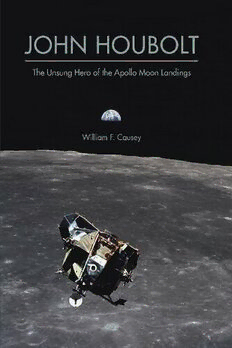
John Houbolt: The Unsung Hero of the Apollo Moon Landings PDF
Preview John Houbolt: The Unsung Hero of the Apollo Moon Landings
“The choice of how to get to the moon was critical to meeting President Kennedy’s goal of a lunar landing ‘before this decade is out.’ Bill Causey’s deeply researched and clearly written book depicts how the persistence of one man, NASA engineer John Houbolt, decisively influenced the tortuous and contentious process of making that choice. This book nicely fills a glaring gap in the history of America’s journey to the moon, and reminds us that the lunar journey was far from straightforward.” —John M. Logsdon, Professor Emeritus, Space Policy Institute, The George Washington University “Causey’s book joins the list of essential reading for people seeking to understand the forces that made possible the Apollo space program. He expertly recalls the venture from the perspective of the people who organized the expeditions, and the sole engineer who convinced the country’s finest spaceflight minds that getting to the moon and back by 1970 required lunar orbit rendezvous. In the process, Causey paints a vivid picture of the inner workings of American government and the making of technical decisions in the mid-twentieth century.” —Howard McCurdy, Professor, American University, Washington, DC “John C. Houbolt was another of the ‘hidden figures’ of NASA during the Apollo era. Bucking institutional blinders, Houbolt convinced the leaders of the space agency that lunar orbit rendezvous was the best way to conduct the Apollo program. William Causey’s biography of Houbolt tells the fascinating story of how this lone engineer battled bureaucracy to help America achieve President Kennedy’s vision, ‘before this decade is out,’ of ‘landing a man on the moon and returning him safely to the earth.’ ” —Roger Launius, author of Reaching for the Moon: A Short History of the Space Race PURDUE STUDIES IN AERONAUTICS AND ASTRONAUTICS James R. Hansen, Series Editor Purdue Studies in Aeronautics and Astronautics builds on Purdue’s leadership in aeronautic and astronautic engineering, as well as the historic accomplishments of many of its luminary alums. Works in the series will explore cutting-edge topics in aeronautics and astronautics enterprises, tell unique stories from the history of flight and space travel, and contemplate the future of human space exploration and colonization. RECENT BOOKS IN THE SERIES Dear Neil Armstrong: Letters to the First Man from All Mankind by James Hansen Piercing the Horizon: The Story of Visionary NASA Chief Tom Paine by Sunny Tsiao Calculated Risk: The Supersonic Life and Times of Gus Grissom by George Leopold Spacewalker: My Journey in Space and Faith as NASA’s Record-Setting Frequent Flyer by Jerry Ross Purdue University Press West Lafayette, Indiana Copyright 2020 by Purdue University. All rights reserved. Printed in the United States of America. Cataloging-in-Publication data is on file with the Library of Congress. Hardcover ISBN: 978-1-55753-946-5 epub ISBN: 978-1-55753-948-9 epdf ISBN: 978-1-55753-947-2 Cover image: NASA Image and Video Library (21 July 1969)— The Apollo 11 Lunar Module ascent stage, with astronauts Neil A. Armstrong and Edwin E. Aldrin Jr. aboard, is photographed from the Command and Service Modules (CSM) during rendezvous in lunar orbit. The Lunar Module (LM) was making its docking approach to the CSM. Astronaut Michael Collins remained with the CSM in lunar orbit while the other two crewmen explored the lunar surface. The large, dark-colored area in the background is Smyth’s Sea, centered at 85 degrees east longitude and 2 degrees south lati- tude on the lunar surface (nearside). This view looks west. The Earth rises above the lunar horizon. The American, by nature, is optimistic. He is experimental, an inventor and a builder who builds best when called upon to build greatly. John F. Kennedy, January 2, 1960, announcing his candidacy for president of the United States The man with a new idea is a crank until the idea succeeds. Mark Twain, Following the Equator, 1897 Contents Abbreviations ix Author’s Note xi Prologue xv PART I Beginnings 1 CHAPTER 1 A Young Engineer 3 CHAPTER 2 Evolution of an Agency 19 CHAPTER 3 The Space Task Group 33 CHAPTER 4 Predicting the Future 43 PART II Ideas 49 CHAPTER 5 From the Earth to the Moon 51 CHAPTER 6 More Committees, Groups, and Panels 57 CHAPTER 7 Parking Orbit 73 CHAPTER 8 Mode Discussions 89 CHAPTER 9 A National Commitment 105
